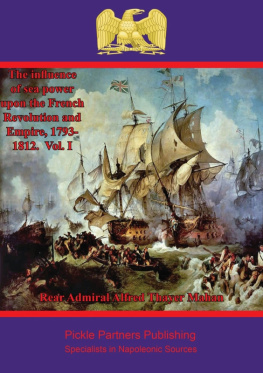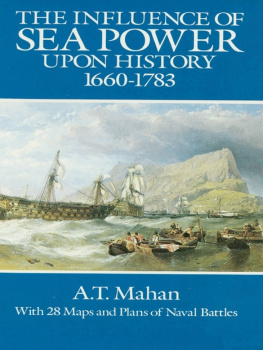FROM
MAHAN
TO
PEARL
HARBOR
FROM
MAHAN
TO
PEARL
HARBOR
The Imperial Japanese Navy
and the United States
SADAO ASADA
NAVAL INSTITUTE PRESS
Annapolis, Maryland
The electronic version of this book has been brought to publication by the generous assistance of Marguerite and Gerry Lenfest.
First Naval Institute Press paperback edition published 2012.
Naval Institute Press
291 Wood Road
Annapolis, MD 21402
This book has been brought to publication with the generous assistance of Edward S. and Joyce I. Miller.
2006 by Naval Institute Press
All rights reserved. No part of this book may be reproduced or utilized in any form or by any means, electronic or mechanical, including photocopying and recording, or by any information storage and retrieval system, without permission in writing from the publisher.
ISBN-13: 978-1-61251-295-2
Library of Congress Cataloging-in-Publication Data
Asada, Sadao, 1936
From Mahan to Pearl Harbor: The Imperial Japanese Navy and the United States / Sadao Asada.
p. cm.
Includes bibliographical references and index.
1. JapanHistory, Naval18681941. 2. Japan. KaigunHistory20th century. 3. JapanForeign relations20th century. 4. World War, 19391945Japan. 5. Mahan, A. T. (Alfred Thayer), 18401914. I. Title.
DS839.7.A87 2006
359.0095209041dc22
2006015540
16 15 14 13 12 8 7 6 5 4 3 2 1
First Printing
To My Esteemed Friend Robert H. Ferrell, and to the Memory of Our Great Teacher Samuel Flagg Bemis (18911973)
CONTENTS

TABLES


A fter many years of research into Japanese and American sourcesI confess I am close to retirement from Doshisha University in KyotoI offer the present essay on the Imperial Japanese Navy spanning the half century preceding Pearl Harbor. It is, of course, a saddening account of a great navy with a tradition and authority that became alienated from and finally clashed with the navy of a neighbor separated by the nine thousand miles of the Pacific Ocean.
To trace the genesis of antagonism I go back to the American ideologue of sea power, Alfred Thayer Mahan; his sea power doctrine; and its influence on the Japanese navy. In 19061907 the two navies, as if in a mirror image, began to see each other as hypothetical enemies. During a happy interlude, the Washington Conference of 192122, the Japanese navy under the charismatic leadership of Admiral Kat Tomosabur cooperated with the United States to dispel a war scare and frame the Washington system of naval limitation. What followed in Japan after Kats untimely death in 1923 was a revolt against the Washington naval treaty, disintegration of the naval tradition, and degeneration of naval leadership until it virtually collapsed in 1941.
I tell the story from the perspective of my own country, but I have been much influenced by my long experience in the United States, where I studied at Carleton College and then, the academic experience of my life, with the late Samuel Flagg Bemis of Yale University. I was Bemiss last doctoral student before his retirement, and I shall never forget his instruction and especially his kindnesses, which were innumerable. He introduced me to a fine dissertation topic, Japan and the United States, 191525, centering on the Washington Conference. This was the start of the pages that follow.
Setting out this large portion of history from 1890 to the fateful day of 7 December 1941 has involved many difficulties. Research in Japanese sources has been formidable, especially in the magnificent and hitherto untapped collections of documents on the Washington, Geneva, and London naval conferences. Alas, the naval and army archives for 193141 suffered systematic destruction at the time of Japans surrender in August 1945 by the highest naval and military leaders, who hastily burned any confidential records that might implicate them in the postwar war crimes trials. I once statedto be sure, helplesslythat the act constituted a crime against history. Nonetheless I have managed to put history back together by supplementing the surviving official records from private sourcesmanuscript collections, diaries, memoirs, and interviews as well as multivolume official war histories.
Sadao Asada
7 December 2005

O ver the years I have profited from interuniversity research projects and Japanese-American historical conferences, most importantly the Kawaguchiko Conference held in July 1969 under the leadership of Hosoya Chihiro. The late Nomura Minoru of the National Defense College (director of the Second Division of the War History Office, the Defense Agency) and the late Admiral Suekuni Masao, also of the War History Office, were of great assistance. The late Admiral Tomioka Sadatoshi, Chief of the Operations Division and, after the war, President of the Historical Sources Research Society, was generous with his time. The late Enomoto Jji, Senior Councilor to the Navy Ministry, kindly invited me to examine his unparalleled collection of interwar naval conference materials at his house in 1975. Hatano Sumio helped me obtain copies of important diaries.
American and British scholars also guided me during their stays in Kyoto. The late Arthur Marder, then working on his Old Friends, New Enemies (1981), befriended me; it was a pleasure to contribute to his Festschrift. He was greatly helpful with a Mahan anthology I was editing and translating. The late British political scientist Joseph Frankel carefully commented on one of my papers from the viewpoint of decision making. In London, D. C. Watt and Ian H. Nish commented on several of my chapters.
My friends in America have done everything in their power, which is a great deal, to be of help. I am especially grateful to Robert H. Ferrell, the most distinguished of Bemiss students, for constantly encouraging and helping me by commenting on and improving my English-language publications. For more than ten years, Edward S. Miller has provided me with friendly support, and he made a generous endowment to the Naval Institute Press on behalf of this book. Robert J. C. Butow took pains to improve the manuscript even though he was so busy with his F. D. Roosevelt and Japan. Dean Allard, Former Director of Naval History, Department of the Navy, was always helpful. It is impossible to name all those to whom I am indebted, so I shall confine myself to several more friends who read and commented on this book manuscript either in part or entirelyJames Auer, Michael A. Barnhart, Waldo H. Heinrichs, Charles E. Neu, Ronald H. Spector, and the late David A. Titus.
In acknowledging the help I received I must also include experiences with such people as Mrs. Theodore Roosevelt Jr. who invited me to her mansion (Old Orchard) on Long Island to examine the papers and diary of her husband and even to be an overnight guest. I fondly recall how I entered the world of the Theodore Roosevelts, pere et fils. That was back in 1959. My years in America included a notable visit in Washington with Ambassador Stanley K. Hornbeck, long of the State Department, where he was Far Eastern adviser to Secretary of State Cordell Hull. He not only let me see portions of his papers in his apartment but also introduced me to Ambassador Joseph C. Grew, my benefactor who made my college education in America possible.
Next page







